Vincent Thomas Bridge
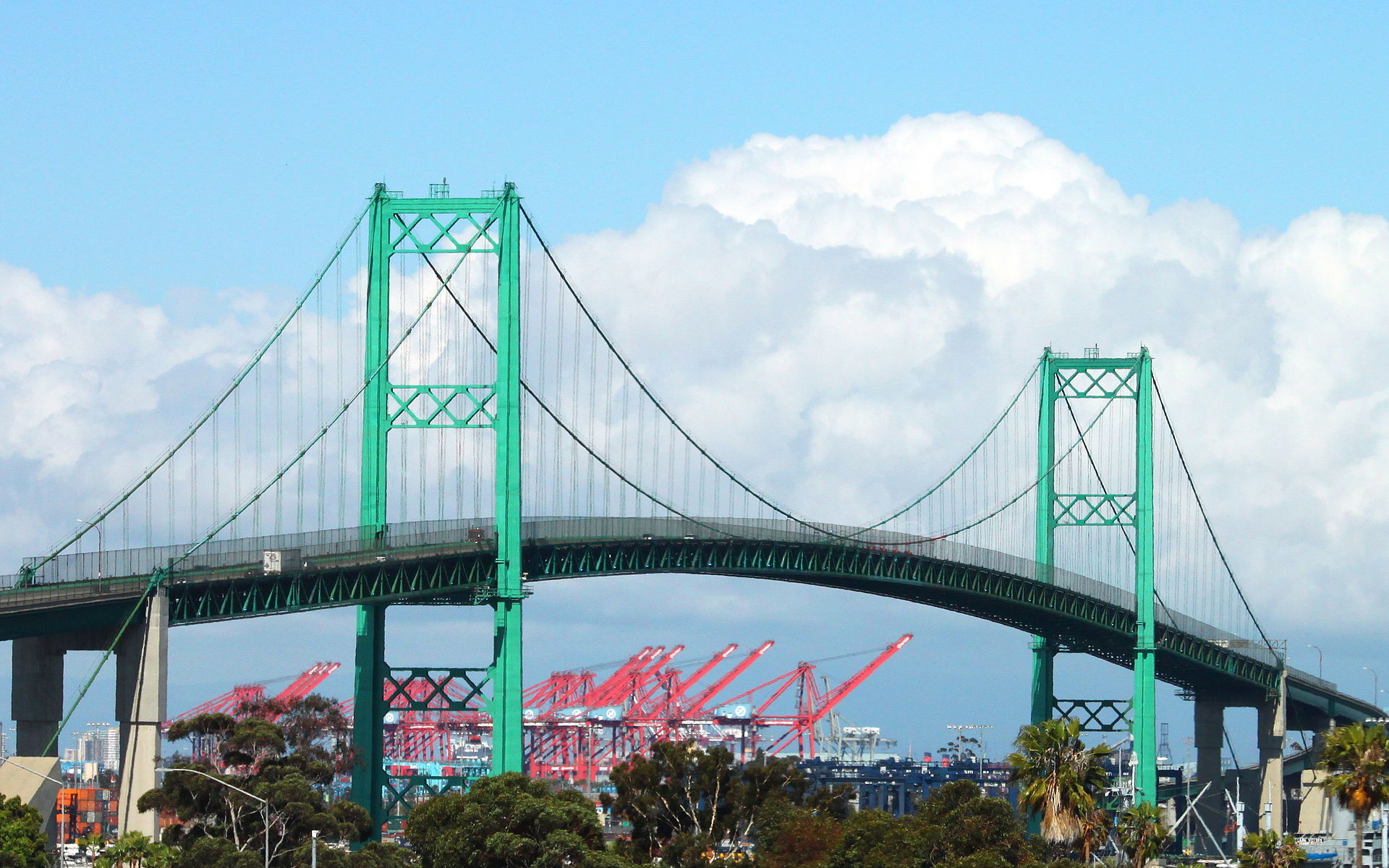 |
|
| (2009)* - An eastbound view of the Vincent Thomas Bridge from San Pedro. |
Historical Notes The Vincent Thomas Bridge is a 1,500-foot-long suspension bridge, crossing the Los Angeles Harbor, linking San Pedro with Terminal Island. It is the only suspension bridge in the Greater Los Angeles area. The bridge is part of State Route 47, which is also known as the Seaside Freeway. The bridge opened in 1963 and is named for California Assemblyman Vincent Thomas of San Pedro, who championed its construction.* |
Construction
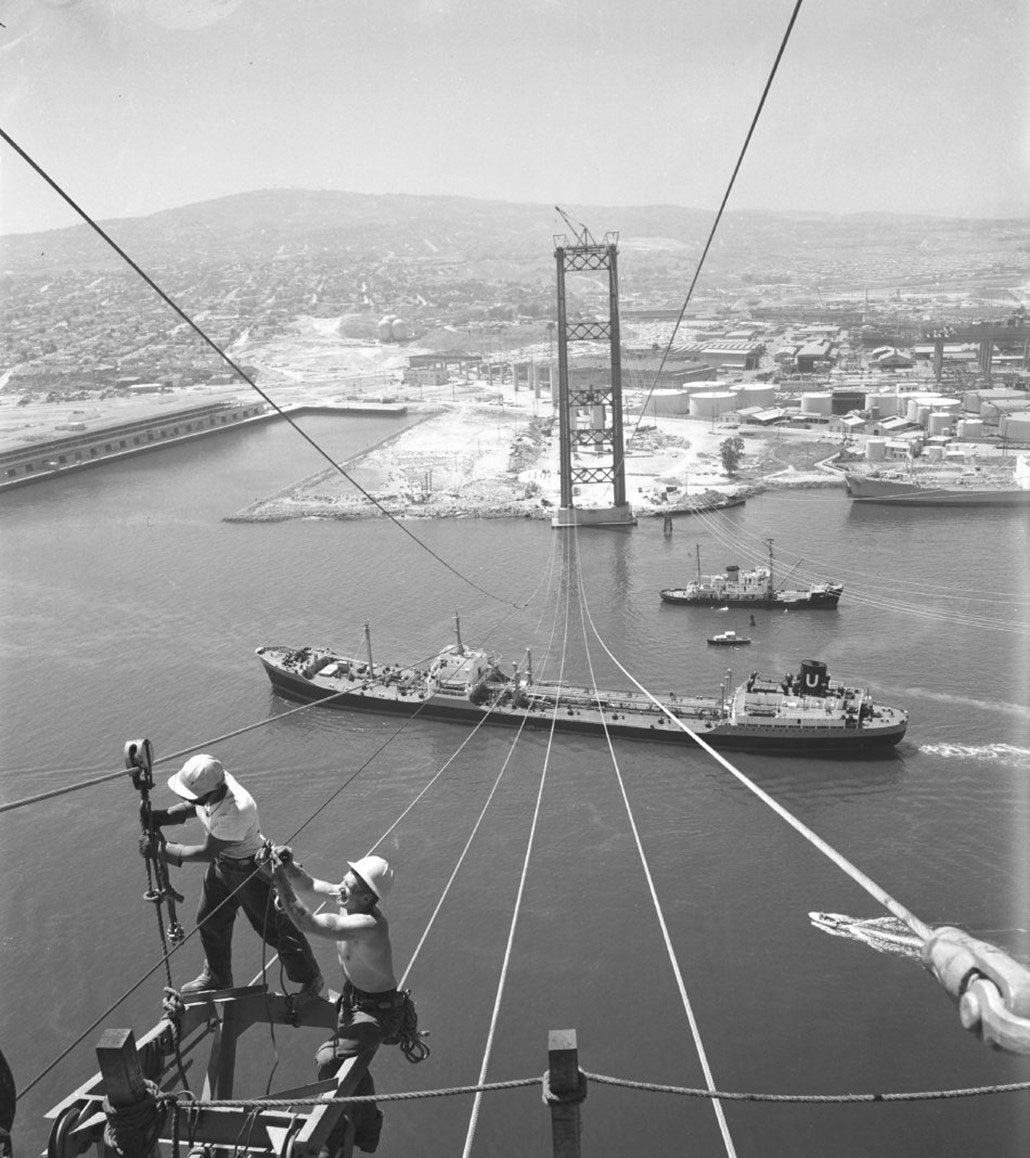 |
|
| (1962) - High Wire Act! - Construction workers work on the suspension cables of the Vincent Thomas. Photo courtesy of L.A. Harbor Department. |
Historical Notes The bridge is 6,060 feet long, 52 feet wide, 365 feet tall. Its longest span is 1,500 feet, and the clearance below is 185 feet. |
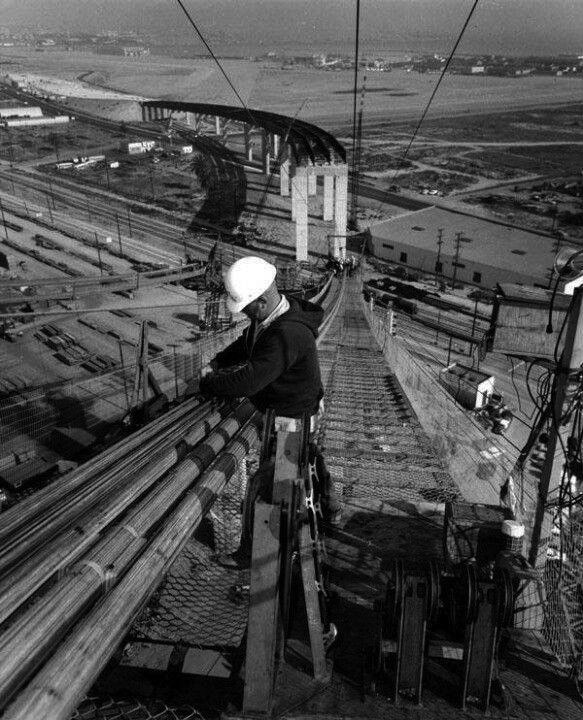 |
|
| (1962)* – A construction worker is seen working on the suspension cable on top of one of the two Vincent Thomas Bridge towers. |
Historical Notes Construction of the bridge required: 14,100 tons of steel; 1,270 tons of suspension cable; 92,000 tons of Portland cement; and 13,000 tons of lightweight concrete. |
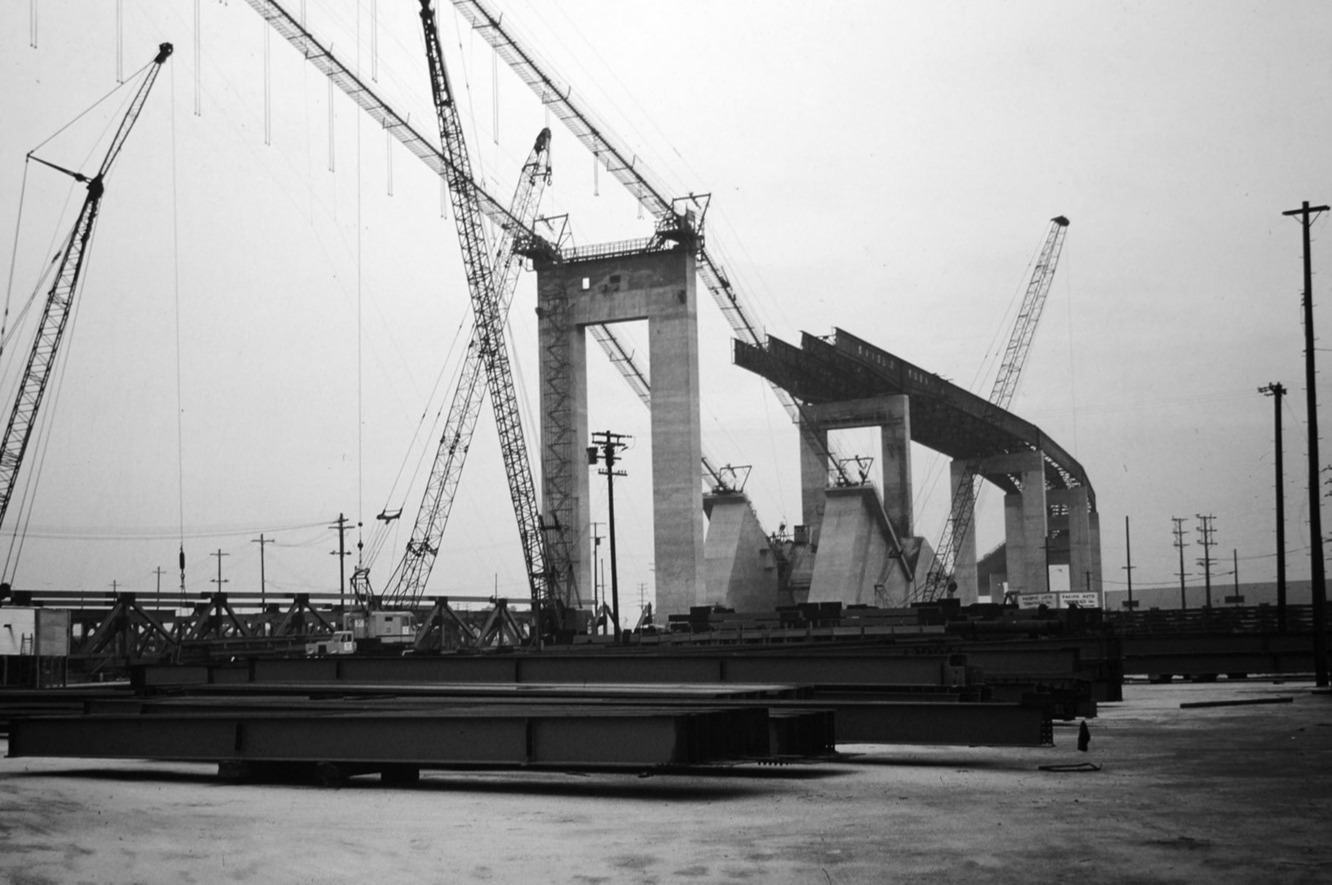 |
|
| (1962)* - The Vincent Thomas Bridge in the early stages of construction with steal beams (girders) still awaiting to be positioned in place. Photo courtesy of Darrel Cowan |
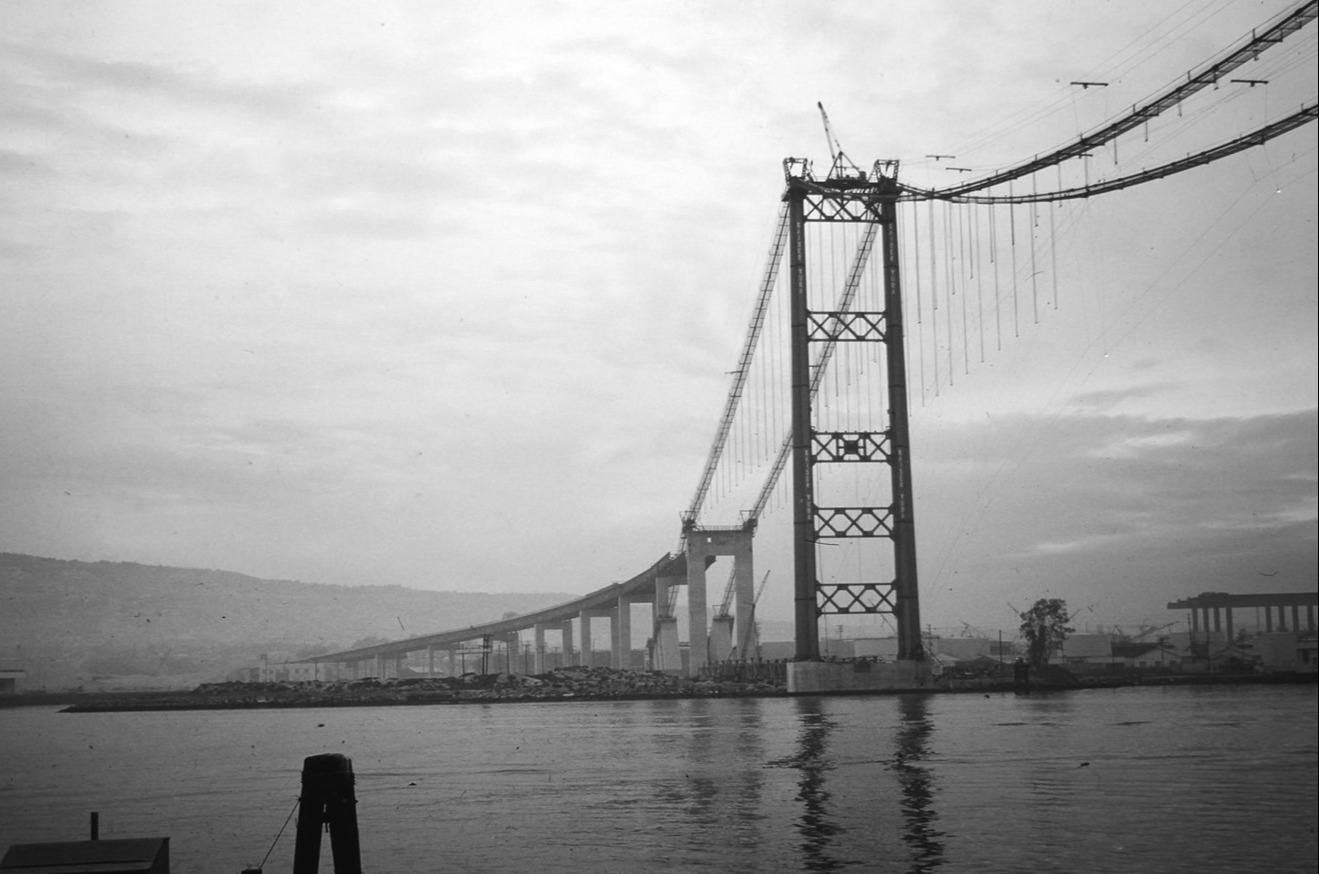 |
|
| (1962)* - The Vincent Thomas Bridge beginning to take form. Photo courtesy of Darrel Cowan |
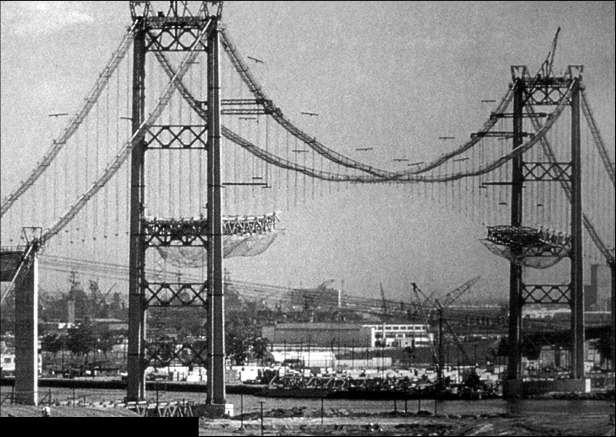 |
|
| (ca. 1962)* - The Vincent Thomas Bridge under construction. It is the fourth largest suspension bridge in the State of California. |
Historical Notes The Vincent Thomas Bridge is the first suspension span ever to be built on steel piles — 990 of them were sunk to hold it up, instead of the more traditional concrete supports. And it is the first to be built entirely without rivets; the steel is welded together. |
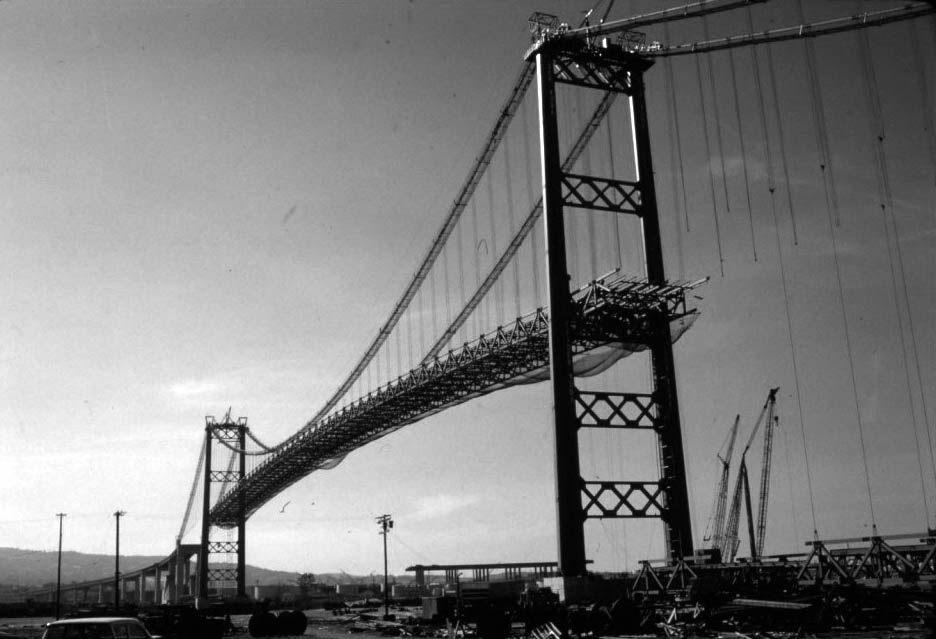 |
|
| (ca. 1963)* - View of the Vincent Thomas Bridge showing its longest span nearly completed. |
Historical Notes The main span of the Vincent Thomas Bridge is 1,500 feet long as compared to the Golden Gate Bridge at 4,200 feet long. |
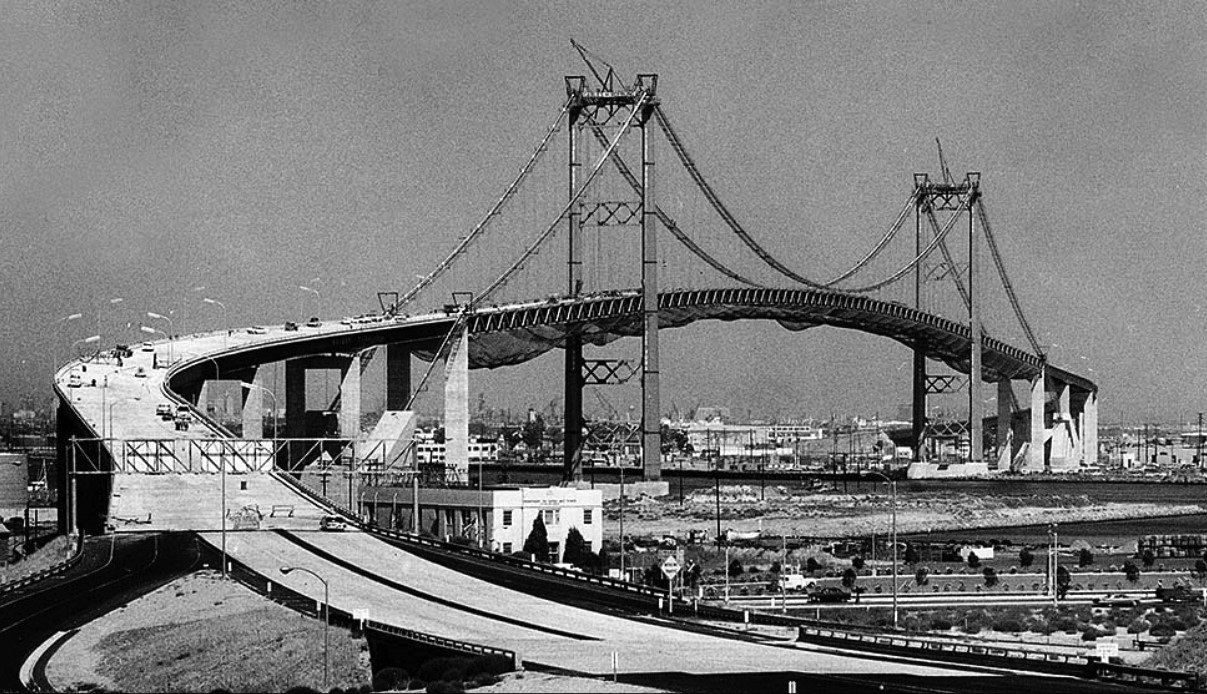 |
|
| (1963)* - The Vincent Thomas Bridge nears completion between San Pedro and Terminal Island. |
Historical Notes California Assemblyman Vincent Thomas, who represented San Pedro, spent 19 years beginning in 1940 arguing for the 16 different pieces of legislation that were necessary for its construction. When the bridge opened in 1963, Thomas was the longest-serving assembyman. In 1961, the legislature passed a special Concurrent Resolution 131 in order to name it after him while he was still serving. |
 |
|
| (1963)* - Panoramic view showing The Islander ferry in its last days of service with the nearly completed Vincent Thomas Bridge in the distance and the Municipal Ferry Building in the foreground. |
Historical Notes In 1963, the Vincent Thomas Bridge was completed connecting the mainland to Terminal Island, and there was no longer a need for ferry service. Accordingly, the ferry service was terminated. The terminal building on the Terminal Island side was demolished, but the building on the San Pedro side was used for many years as an office building by the Los Angeles Harbor Department. As the ferry building began to deteriorate, citizens of San Pedro sought to have it restored. They succeeded in having the building designated as a Historic-Cultural Monument (No. 146) in 1975, and starting in 1976 the building was renovated and converted into the Los Angeles Maritime Museum. The museum opened in 1979. The building was listed in the National Register of Historic Places in 1996.* |
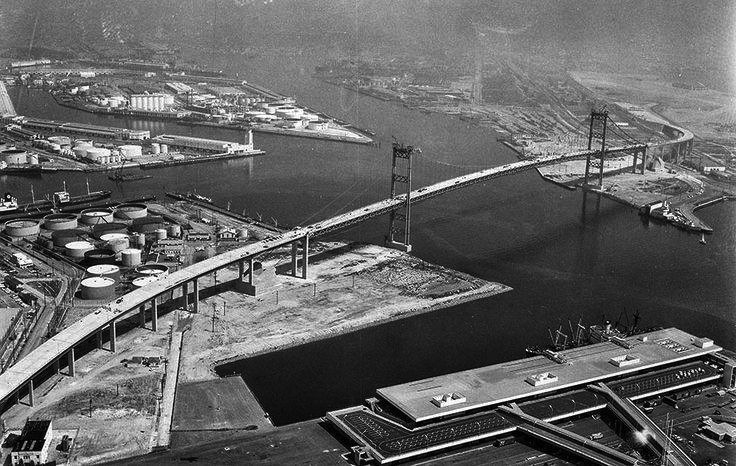 |
|
| (1963)* – Aerial view looking down at the newly completed Vincent Thomas Bridge. |
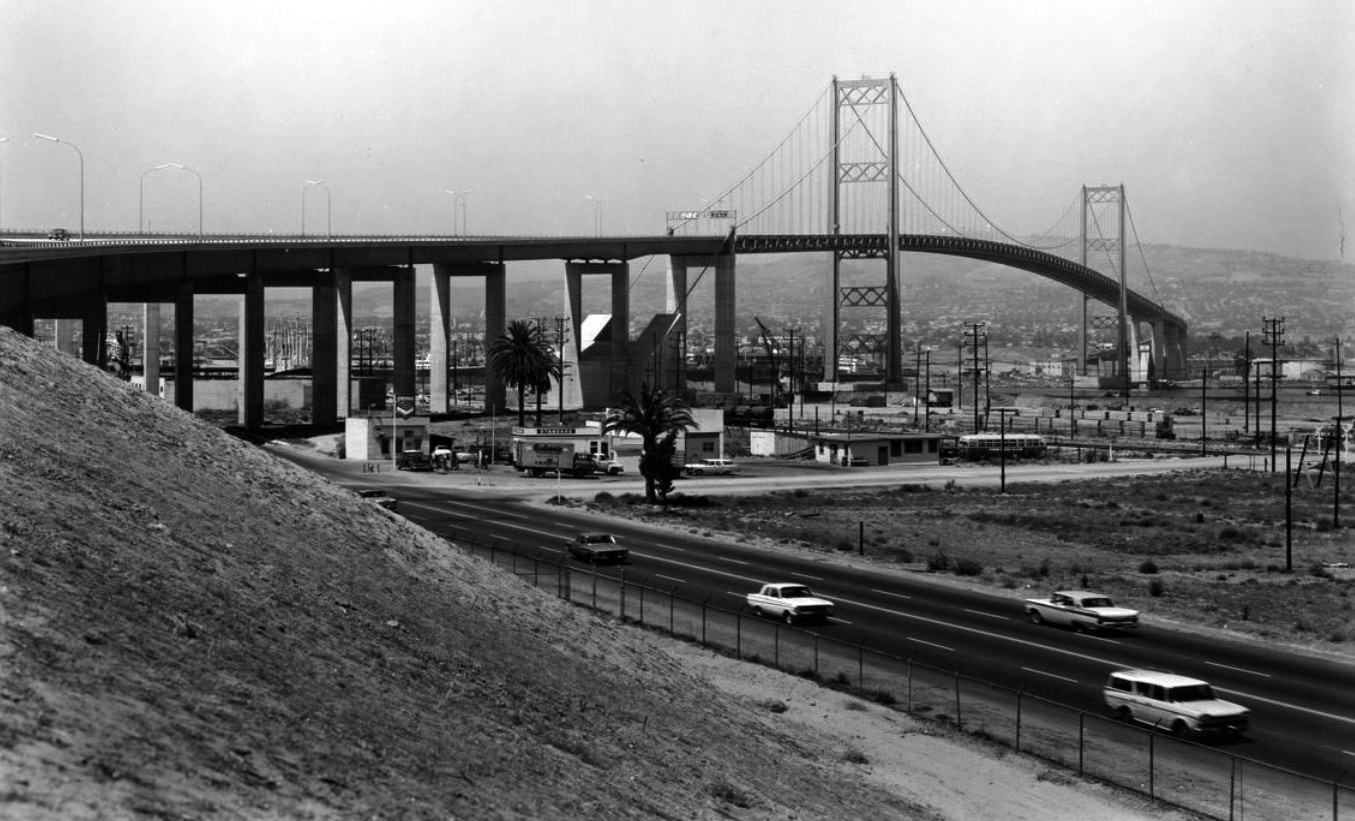 |
|
| (1963)* – View from the hillside showing the newly completed Vincent Thomas Bridge. |
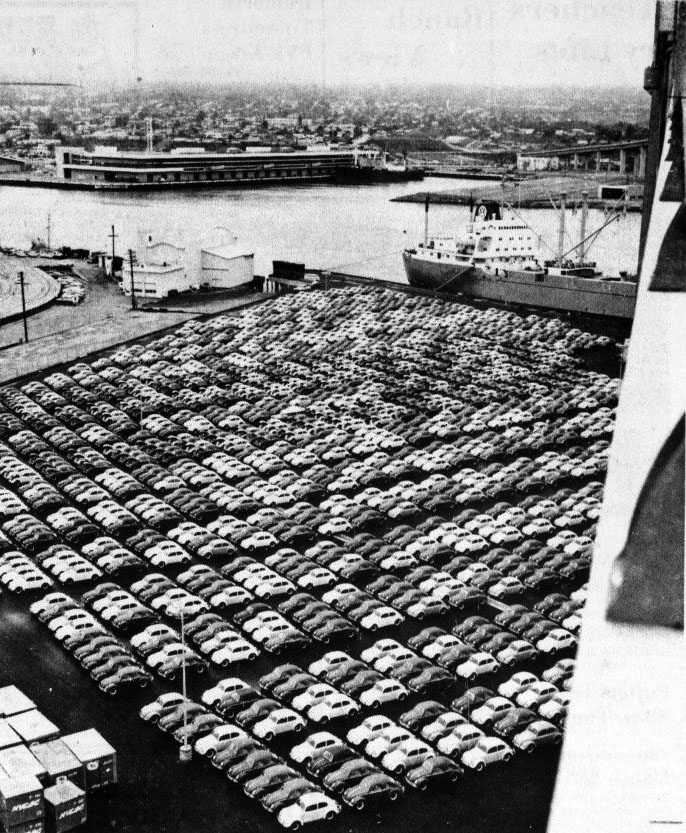 |
|
| (ca. 1964)^ - View looking down from the Vincent Thomas Bridge showing VW Beetles as far as the eye can see. |
Historical Notes The Volkswagen Beetle, or informally the Volkswagen Bug, was produced from 1938 until 2003. The need for this kind of car, and its functional objectives, were formulated by Adolf Hitler, leader of Nazi Germany, wishing for a cheap, simple car to be mass-produced for the new road network of his country. He contracted Porsche in 1934 to design and build it to his exacting standards. Ferdinand Porsche and his team took until 1938 to finalize the design. This is one of the first rear-engined cars. With over 21 million manufactured in an air-cooled, rear-engined, rear-wheel drive configuration, the Beetle is the longest-running and most-manufactured car of a single design platform, worldwide. |
.jpg) |
|
| (ca. 1964)* - One of the world’s largest car carriers at the time, Volkswagen ship Johann Schulte, arrives at the Port of Los Angeles. View shows 100s of VW Beetles, all lined up and waiting for transport to dealerships. The newly opened Vincent Thomas Bridge stands tall in the background. |
Historical Notes The original 25 hp Beetle was designed for a top speed around 100 km/h (62 mph), which would be a viable cruising speed on the Reichsautobahn system. As Autobahn speeds increased in the postwar years, its output was boosted to 36, then 40 hp, the configuration that lasted through 1966 and became the "classic" Volkswagen motor. |
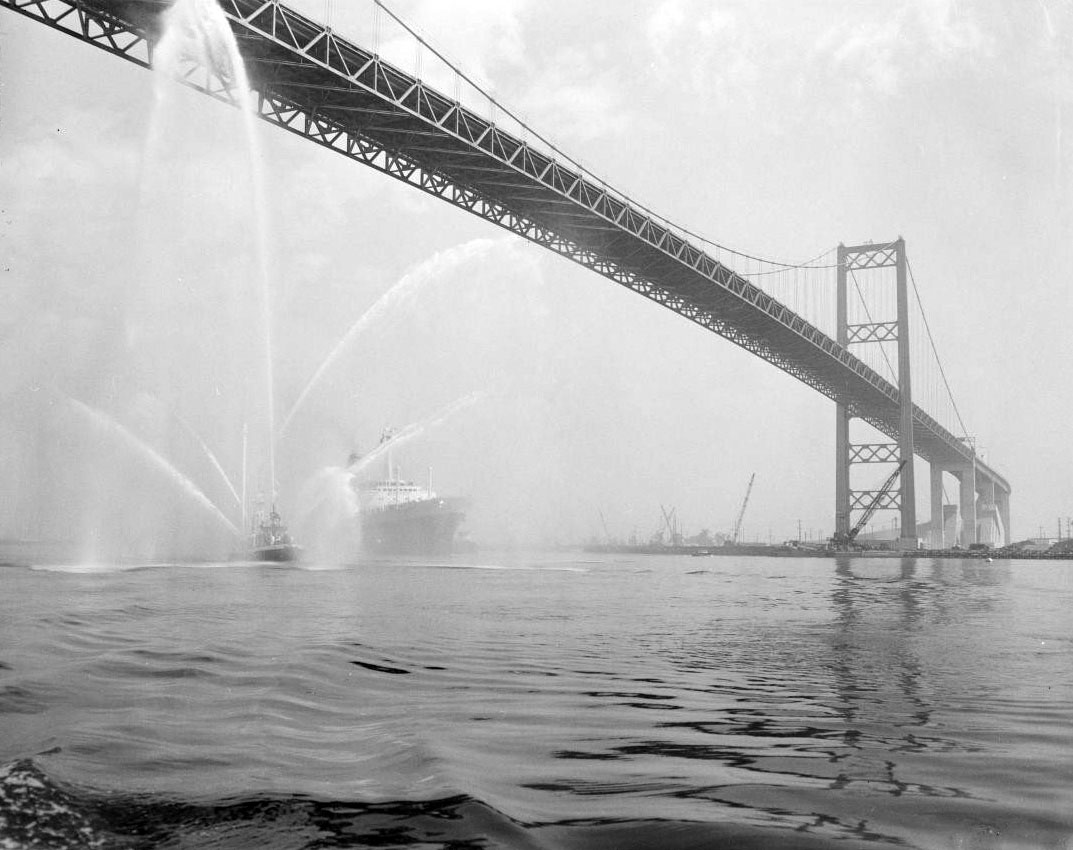 |
|
| (1964)* – S.S. Statendam’s gets a water salute on its departure as it sails under the Vincent Thomas Bridge. |
Historical Notes SS Statendam was an ocean liner of the Holland America Line built in 1957. She was bought by the Paquet group in 1982 and renamed Rhapsody and sold again to the Lelakis group in 1986. Later she became part of the Regency Cruises fleet and was named Regent Star in the Regency fleet. She was laid up after the Regency Cruises bankruptcy and remained in poor condition for many years. She was scrapped in Alang, India in 2004.^ |
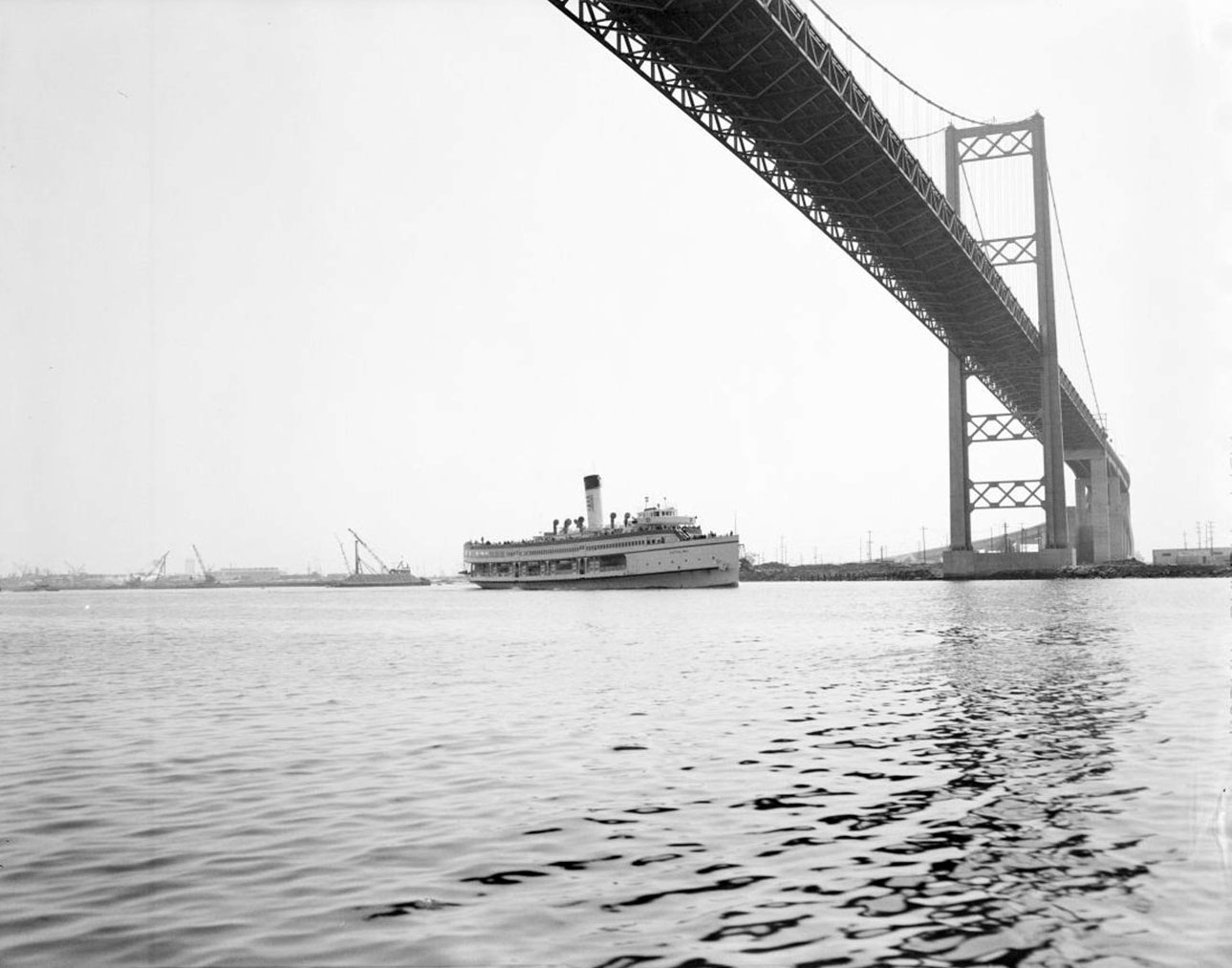 |
|
| (1964)* – SS Catalina departs the Port of LA on a short cruise to Santa Catalina Island. |
Historical Notes SS Catalina, also known as The Great White Steamer, was a 301-foot steamship built in 1924 that provided passenger service on the 26-mile passage between Los Angeles and Santa Catalina Island from 1924 to 1975. According to the Steamship Historical Society of America, Catalina has carried more passengers than any other vessel anywhere. From August 25, 1942 until April 22, 1946 the ship served as the Army troop ferry transporting more than 800,000 troops and other military personnel between embarkation camps and the departure piers. After a period of service as a floating discothèque, the ship ran aground on a sandbar in Ensenada Harbor in 1997 and partially sank on the spot. It was scrapped in 2009.^ |
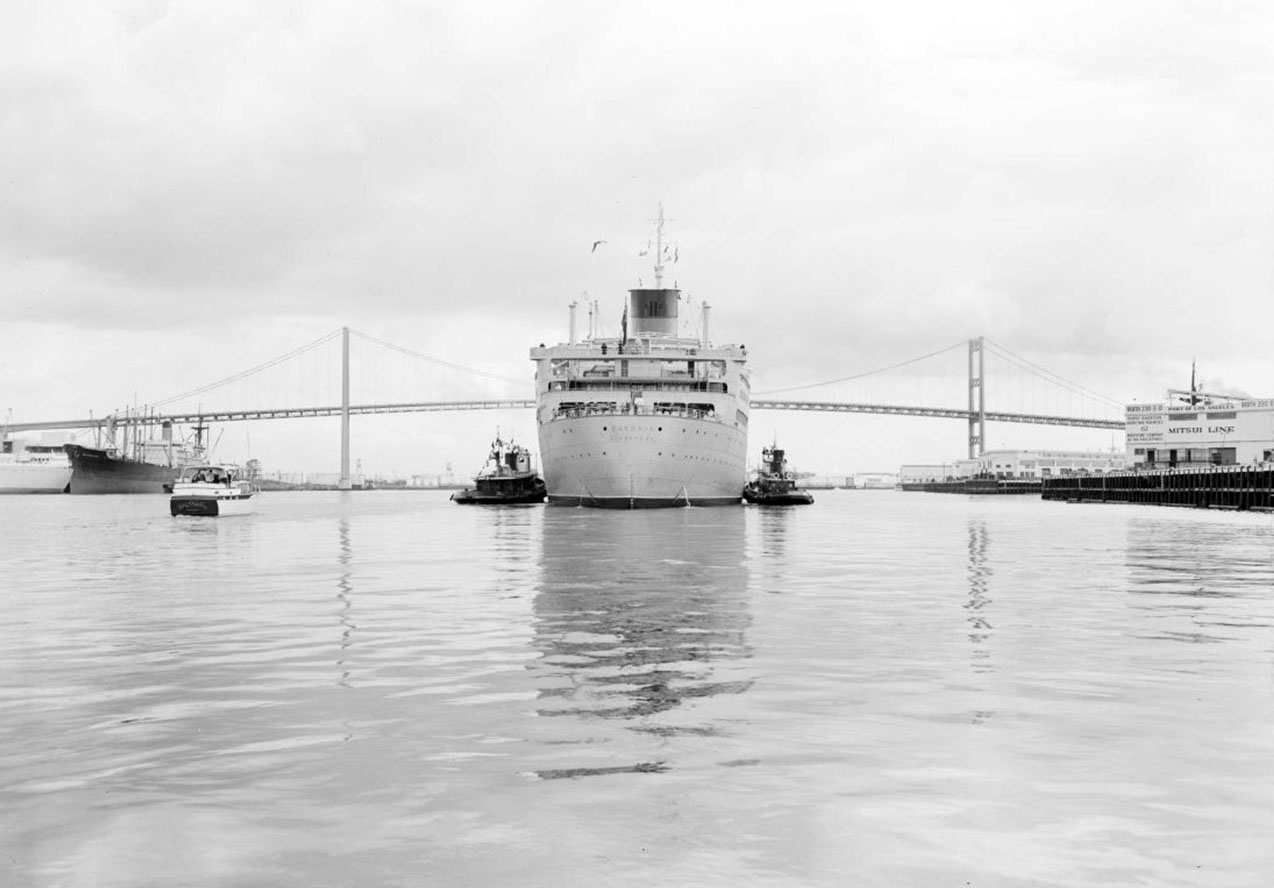 |
|
| (1964)* - M.S. Caronia arrives in the Port of L.A. with the Vincent Thomas Bridge seen in the background. |
Historical Notes RMS Caronia was a passenger ship of the Cunard Line (then Cunard White Star Line). Launched on 30 October 1947, she served with Cunard until 1967. She was initially nicknamed the "Green Goddess" after Liverpool's green and white "Green Goddess" trams, and the nickname stuck. She was one of the first "dual-purpose" ships, built both for 2-class transatlantic crossings and all 1st-class cruising. After leaving Cunard she briefly served as SS Caribia in 1969, after which she was laid up in New York until 1974 when she was sold for scrap. While being towed to Taiwan for scrapping, she was caught in a storm on 12 August. After her tow lines were cut, she repeatedly crashed on the rocky breakwater outside Apra Harbor, Guam and broke into three sections. |
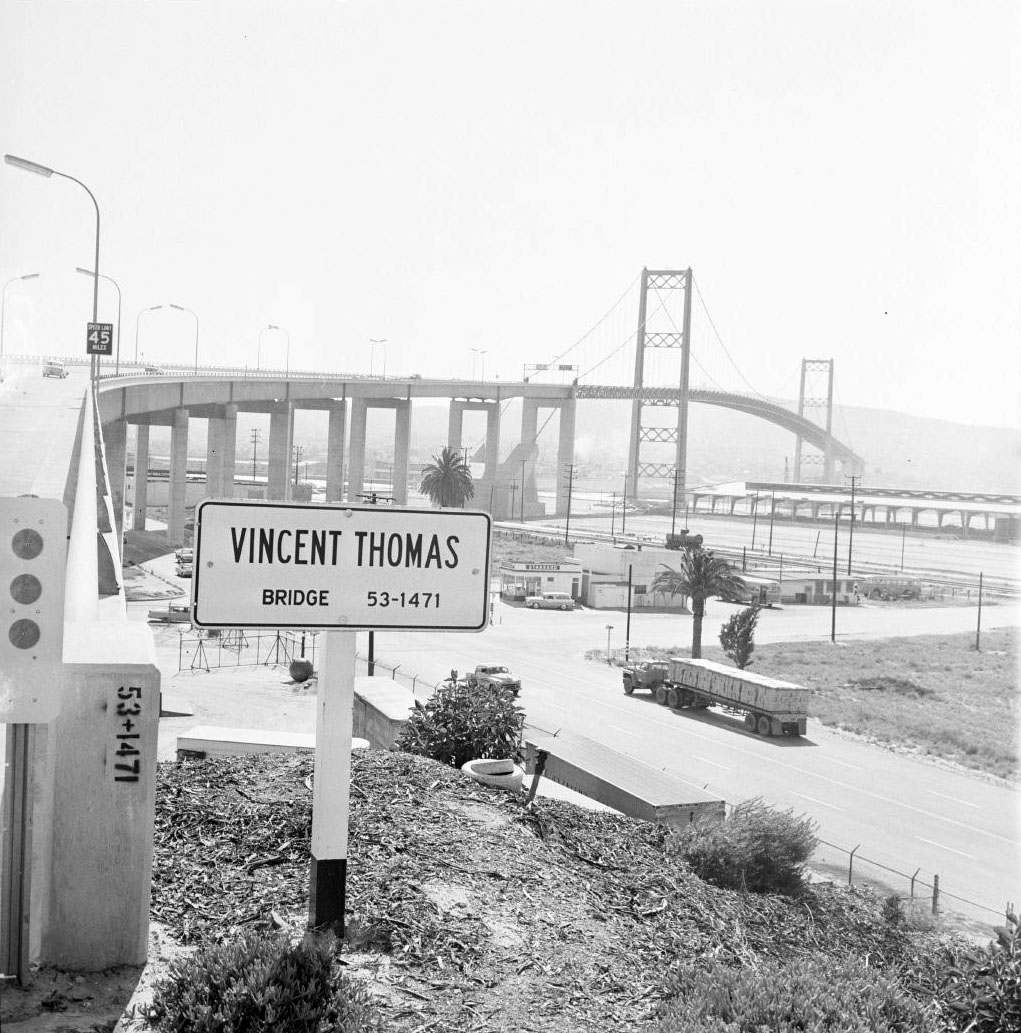 |
|
| (1965)* - Daytime view of the Vincent Thomas Bridge as the fog burns off. |
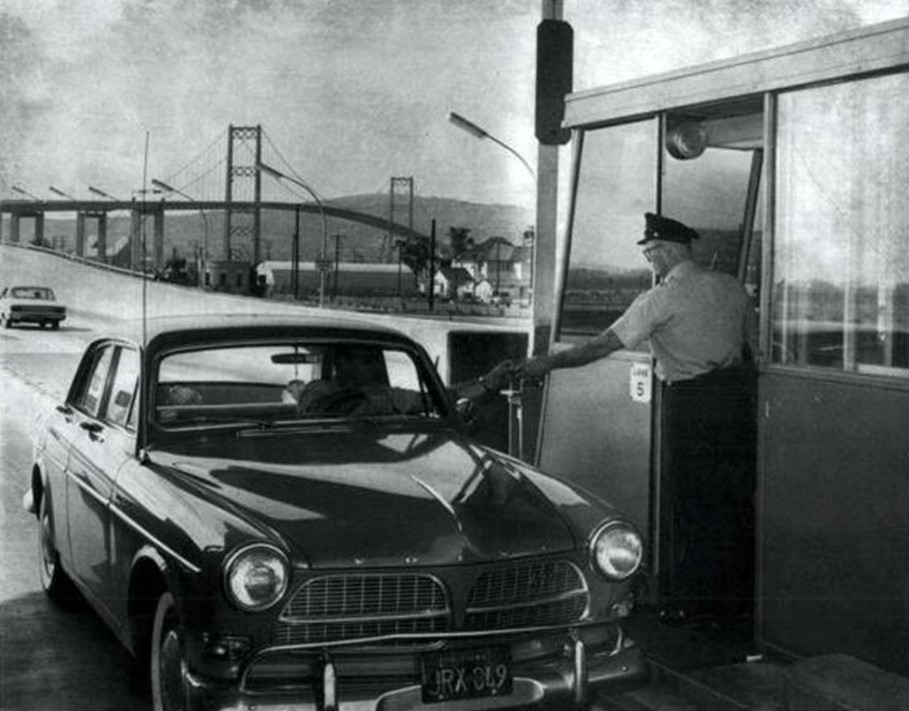 |
|
| (1965)* - A Volvo stops to pay the 25-cent toll to cross the Vincent Thomas Bridge. |
Historical Notes When the Bridge opened in 1963, a 25-cent toll was collected in each direction. On grand opening day, Assemblyman Thomas paid the first toll. In 1983, the toll increased to 50 cents for westbound traffic and was free for eastbound traffic. In 2000, the Bridge was considered “paid for” and the toll was repealed. |
 |
|
| (1988)* - Traffic streams across the Vincent Thomas Bridge at dusk. |
Historical Notes Skeptics predicted it would serve fewer than 2,000 vehicles a day and that it would take taxpayers 40 years to pay for the $21-million structure. In its first month of operation, however, the bridge served a daily average of 9,631 vehicles. And most of the debt was paid off within 20 years. |
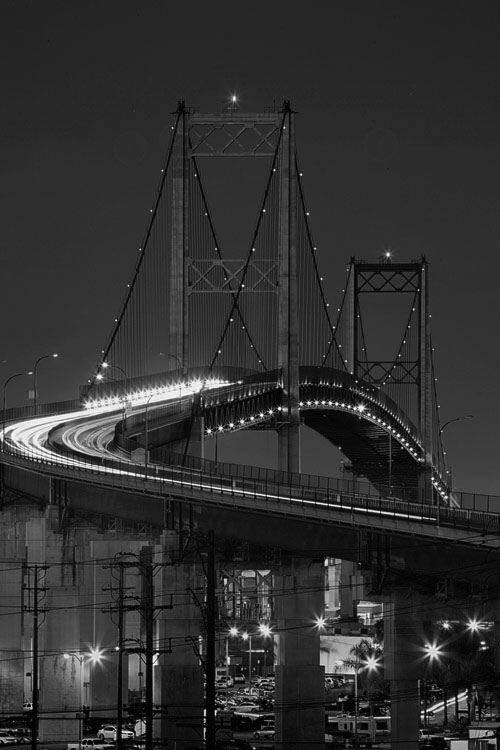 |
|
| (ca. 2010s)* – Night view showing the Vincent Thomas Bridge. |
Historical Notes Los Angeles police say a suicide attempt is made from the bridge "every few months". |
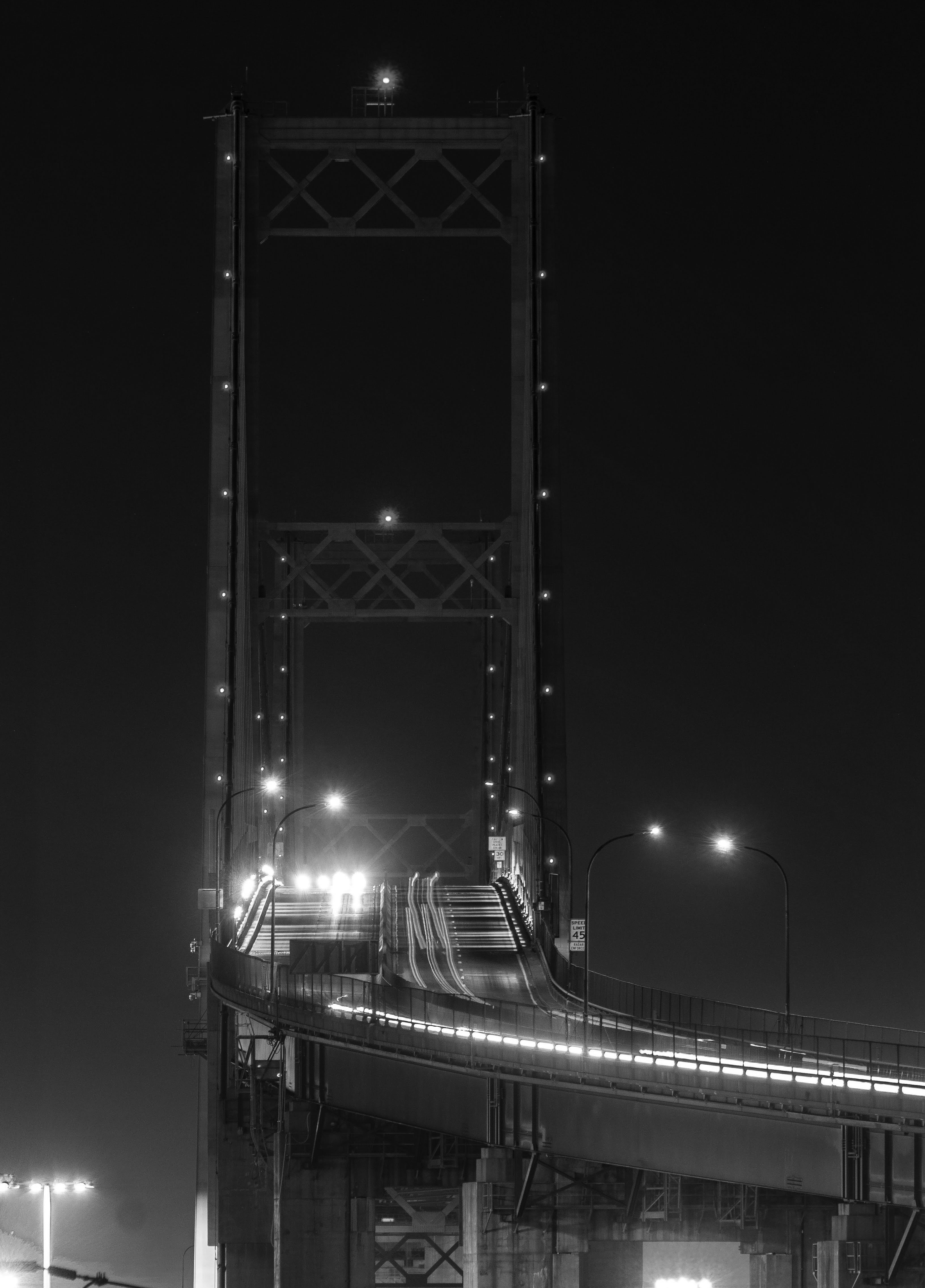 |
|
| (2019)* - View of the Vincent Thomas Bridge in San Pedro as seen from the Knob Hill Little League Field. |
Historical Notes The 4-lane, 2.2 mile bridge, whose towers rise 35 stories above LA's Harbor, replaced ferry service between San Pedro and Terminal Island in 1963. |
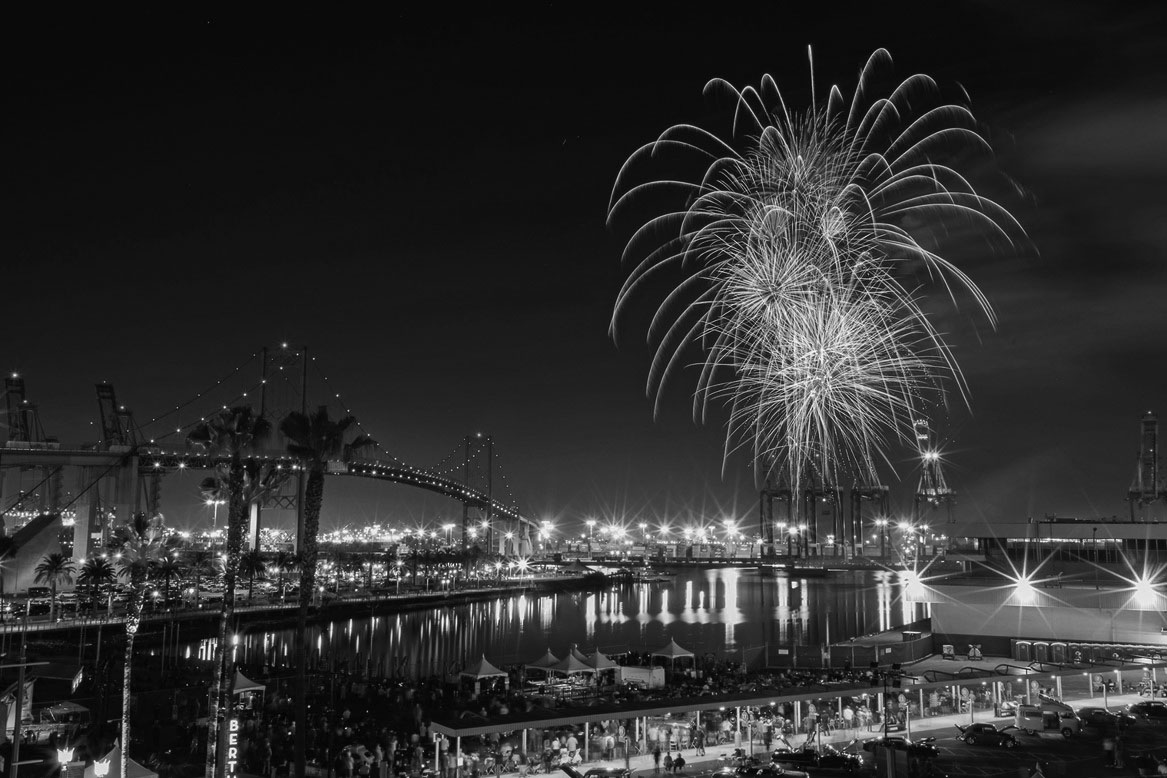 |
|
| (2020)* – Fireworks at Port of Los Angeles by the Vincent Thomas Bridge. Courtesy of the Port of Los Angeles |
| (2009)* – The Vincent Thomas Bridge viewed from 11,500 feet. A cruise ship is seen in dock, as well as a cargo ship. The Victory Ship SS Lane Victory is also visible, moored between the cruise ship and the bridge. |
Historical Notes The spectacular Vincent Thomas Bridge is the "Official Welcoming Monument" to Los Angeles. The suspension bridge daily welcomes thousands of people to LA's major seaport district of San Pedro as well as the port. |
Then and Now
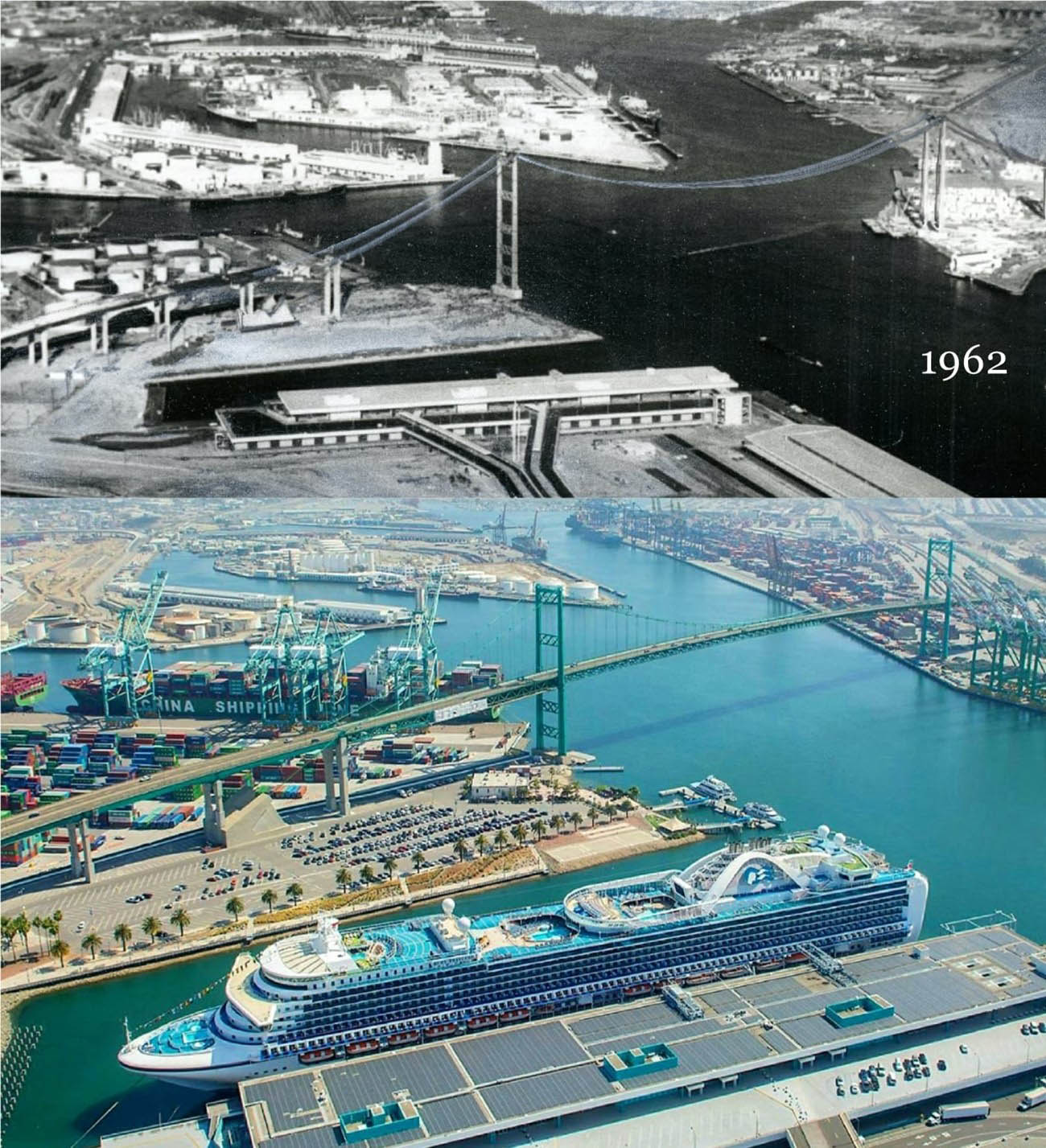 |
|
| (1962 - 2020s)* - Vincent Thomas Bridge with the Los Angeles World Cruise Center in the foreground. |
Historical Notes The Port of Los Angeles World Cruise Center began life as a freight and passenger terminal for the American President Lines. It was later converted into a cruise ship facility and became home to the “Love Boat”. As the size and number of cruises ships increased, the cruise ship center underwent a 21 million dollar major renovation and improvement project in 2003. Today the Port of Los Angeles World Cruise Center serves as the West Coast’s largest cruise port with hundreds of thousands of passengers using the facility. It can accommodate the biggest cruise ships. |
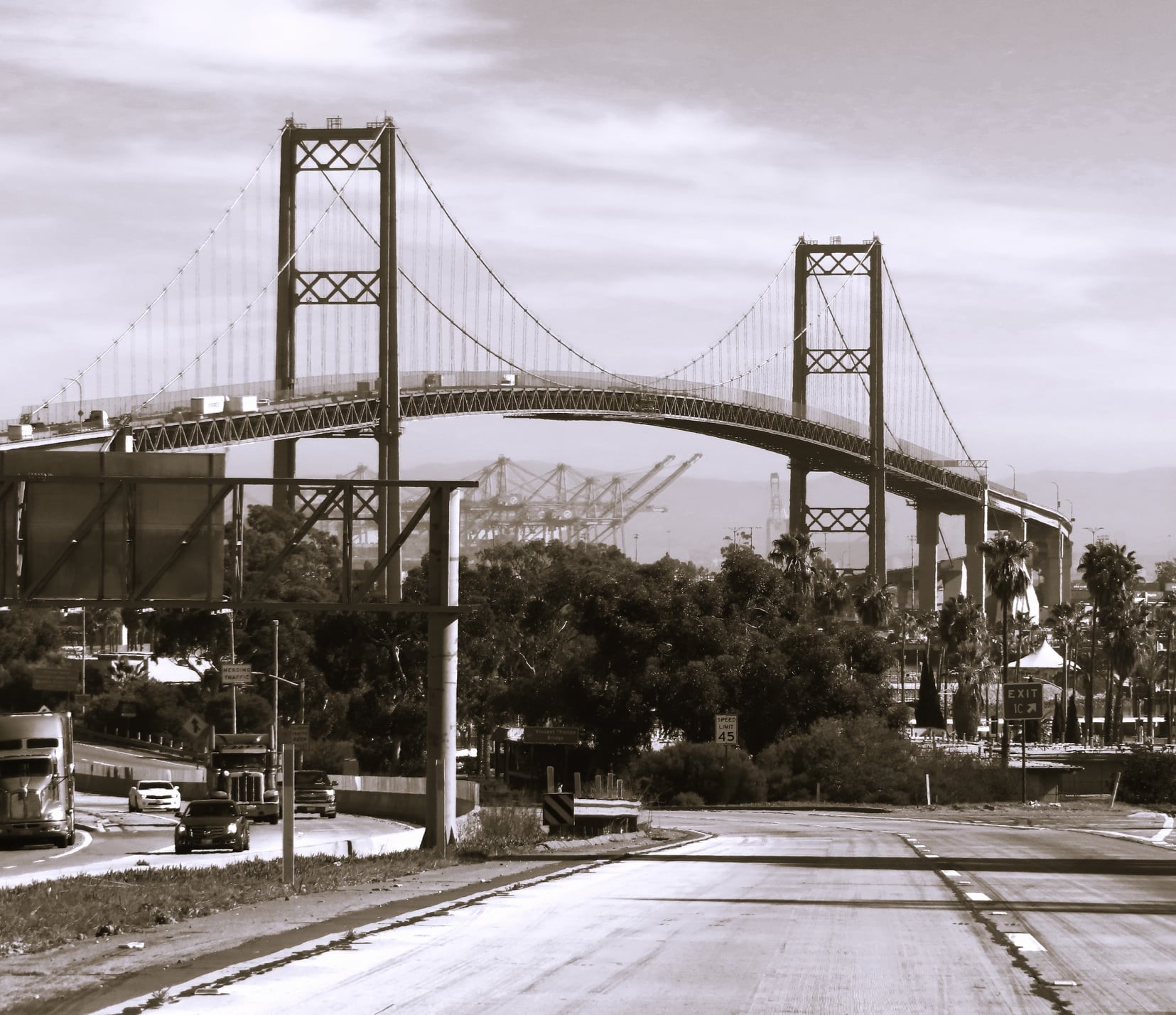 |
|
| (2022)* - Vincent Thomas Bridge – Photo by Howard Gray |
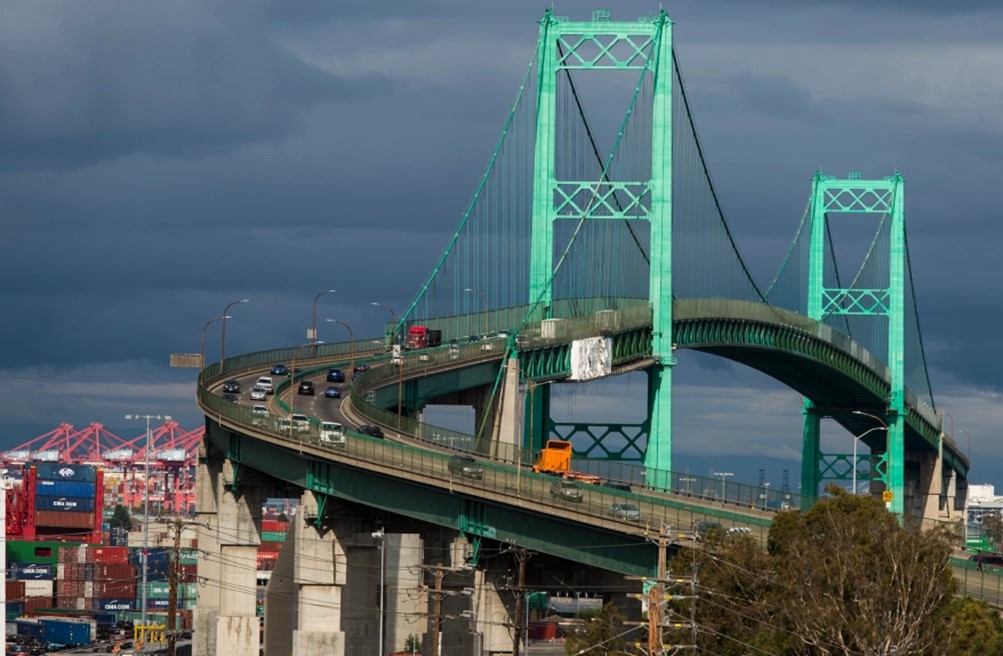 |
|
| (2015)* – The sun shines down onto the Vincent Thomas Bridge after a storm moves through Southern California in San Pedro. (Thomas R. Cordova Press-Telegram/Daily Breeze) |
Historical Notes The first thing people notice, during the day, is its magnificent "green" color. It takes more than 1,000 gallons of green paint to cover its span. |
* * * * * |
|
Other Sections of Interest |
|
Water and Power in Early LA |
|
Newest Additions |
New Search Index |

A new SEARCH INDEX has been added to help navigate through the thousands of topics and images found in our collection. Try it out for a test run.
Click HERE for Search Index |
* * * * * |
< Back
Menu
- Home
- Mission
- Museum
- Major Efforts
- Recent Newsletters
- Historical Op Ed Pieces
- Board Officers and Directors
- Mulholland/McCarthy Service Awards
- Positions on Owens Valley and the City of Los Angeles Issues
- Legislative Positions on
Water Issues
- Legislative Positions on
Energy Issues
- Membership
- Contact Us
- Search Index
© Copyright Water and Power Associates
Layout by Rocket Website Templates